
World Bank’s Global Equality Index has positioned India ahead of traditionally dominant economies
Breaking Barriers, India’s Unexpected Rise in Global Equality Rankings
Equality Leap of India – In a revelation that surprised economists and analysts alike, the World Bank Global Equality Index has positioned India ahead of traditionally dominant economies like the United States and China. The report gauges income distribution, access to essential services, gender parity, and opportunities for marginalized communities, factors long seen as India’s uphill battles.
But recent strides have flipped the narrative.
India’s Gini coefficient, a measure of income inequality, has dipped to its lowest level in decades. In contrast, the US showed rising disparities, and China faced stagnation. While India once struggled with vast income gaps and rural exclusion, reforms in welfare targeting, education, and digital accessibility have played transformative roles.
Key drivers include:
- Direct Benefit Transfers (DBT) that reduce leakages in welfare schemes
- PM-KISAN and Jan Dhan Yojana which empower rural households
- Digital India bridging the urban-rural connectivity divide
- Gender-based scholarships and legal amendments promoting inclusion
Former skeptics are now calling it a “quiet revolution” where policy meets purpose. The shift is not only statistical, it’s philosophical. India is embracing equity as a national ethic.
The Engines of Equality, Policy Reform, Digital Access, and Civic Inclusion
India’s transformation didn’t happen overnight. It’s the result of methodical reform, technology-fueled reach, and empowered governance. Unlike flashy announcements, India’s equality journey has relied on grassroots execution and scalable models of impact.
Economic Measures
Schemes like Ujjwala Yojana and Affordable Housing Missions have changed lives at the base of the pyramid. Instead of top-down trickle economics, India’s strategy focuses on lifting from the bottom up, creating a more uniform foundation of prosperity.
Tech as a Tool for Equity
The Aadhaar-linked DBT system revolutionized transparency. Subsidies, scholarships, and pensions now reach intended recipients without middlemen. This efficiency discourages corruption and empowers citizens, especially in rural belts.
Gender and Social Inclusion
India’s push for women-led development through self-help groups and microfinancing has added social capital to economic growth. Inclusive hiring practices in government and incentives for minority education have also contributed.
As per the World Bank, these policies have helped India reduce inequality while growing economically, a rare achievement. Unlike fast GDP growth accompanied by wider gaps (as seen in China and the US), India’s model holds a unique blend of progressive capitalism and inclusive governance.
Redefining Global Narratives, India’s Equality Surge Inspires a New Role on the World Stage
The implications of this report extend beyond domestic cheer. India’s rising equality index challenges the notion that economic growth and social justice are mutually exclusive. It presents a scalable template for nations in the Global South looking to balance development with dignity.
International think tanks now view India not just as a market, but as a model. As global economies grapple with inflation, jobless growth, and rising polarization, India’s hybrid approach, mixing democracy, digitization, and decentralized welfare is winning admiration.
With the 2025 G20 Equity Summit on the horizon, India is expected to push for more global cooperation on:
- Data-driven poverty measurement
- Transparent subsidy frameworks
- Youth and skill development exchanges
Furthermore, India’s equality surge adds a new dimension to its geopolitical voice. In dialogues where power dynamics traditionally overpowered equity concerns, India’s moral standing is growing.
Yet challenges remain. Urban-rural gaps still exist. Regional disparities need attention. Education and healthcare quality vary. But the direction is clear and the momentum is historic.
As Nobel laureate Amartya Sen once noted, “Development is freedom.” India seems to have taken that mantra from philosophy to public policy, redefining its purpose on the world stage not just as an economic powerhouse, but as a standard bearer of social transformation.
Stay updated with the latest news on Rapido Updates. Keep yourself updated with The World, India News, Entertainment, Market, Automobile, Gadgets, Sports, and many more
1 thought on “Equality Leap of India: Surpasses US and China in Historic World Bank Ranking”